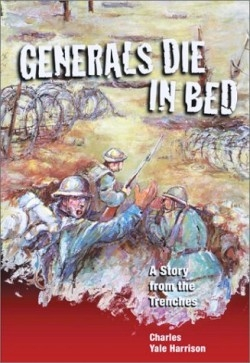Generals Die in Bed A Story from the Trenches
In an age when war is often high-tech and the enemy impersonal, the events of September 11 put terrorists and victims face to face in the narrow confines of four doomed airplanes. Fear, the brutal murders of people begging for mercy, and the heroic response of passengers can only be vividly imagined. Those brief, terrible, personal encounters evoke the battlefields of World War I, as described in this book.
The author, an American working in Canada, served with the Royal Montreal Regiment during the war. His fictionalized account of experiences in the vermin-filled trenches of Europe does not glorify the experience. First published in 1930, the book leaves no doubt that combat was brutal, conditions severe, and recruits not likely to die in the comfort of a bed. This new edition includes an introduction that places the book in context, plus a map of the front and archival photographs.
The narrator never tells us about himself, not even his name. Just eighteen years old, he is among recruits in Montreal who are headed overseas-plunged quickly from a brothel to battle. Fear is palpable as the narrator and his companions soon stand watch in the trenches trying to “fancy the horrors” of battle. The silence is broken by gunfire, and the author’s graphic, almost poetic descriptions of war begin. The night “whistles and flashes red.” The pale yellow smoke of explosives is “the color of boarding-house tea.” The horrors become real.
The writing style is a terse staccato, echoing gunfire and pounding hearts, and reinforcing tension. The young men scratch lice, look forward to every meager scrap of food, and tend to their bloody, blistering feet.
Missing normal life and women, the soldiers eagerly memorize every detail of Brownie’s two-week marriage prior to service. When Brownie is killed, the narrator helps pull his body from the mud, then Brownie’s portion of sugar is quickly divided among the survivors. They have time to reflect later while they take sanctuary in a field of blossoming beans. “We speak respectfully now? He is not the awkward, stupid boy we knew. He is a symbol? He is a dead farmer.”
One of the most emotional moments of the book comes when the narrator kills a German solider with his bayonet. It is not the clean, swift killing that he intended, and the gruesome incident is haunting. The narrator is, after all, young and human, fighting hard, doing what he is told, even when tricked by superior officers. He comforts dying friends, but looks out for himself when necessary.
Harrison later wrote several other books, including a biography of lawyer Clarence Darrow, and one about his own heart attack. Period photographs add to the book’s gritty, poignant reality. This powerful literary work deserves an audience beyond young adults.
Reviewed by
Linda Salisbury
Disclosure: This article is not an endorsement, but a review. The publisher of this book provided free copies of the book to have their book reviewed by a professional reviewer. No fee was paid by the publisher for this review. Foreword Reviews only recommends books that we love. Foreword Magazine, Inc. is disclosing this in accordance with the Federal Trade Commission’s 16 CFR, Part 255.

